#HVLE
Explore tagged Tumblr posts
Text

159 011 in Wustermark/Elstal am 29.03.2025
#159 011#Br159#Br 159#Elstal#Wustermark#Eurodual#Stadler Eurodual#Stadler#HVLE#eisenbahn#bahnhof#bahn#berlin#brandenburg#Havelländische Eisenbahn
15 notes
·
View notes
Text

159 010 in Werder/Havel am 11.04.2025
#159 010#Br159#Br 159#HVLE#Havelländische Eisenbahn#Havelland#Havelländische Eisenbahngesellschaft#eisenbahn#bahnhof#bahn#berlin#brandenburg#Stadler Eurodual#Eurodual#Stadler#Werder#Werder/Havel#Havel
14 notes
·
View notes
Text

159 012 in Saarmund am 14.03.2025
#159 012#Br159#Br 159#Eurodual#Stadler Eurodual#Stadler#Hvle#Güterzug#Saarmund#BAR#südlicher BAR#Berliner Außenring#eisenbahn#bahnhof#bahn#berlin#brandenburg
7 notes
·
View notes
Text

285 001 in Bamberg am 26.01.2021
7 notes
·
View notes
Text

203 142 in Elstal am 17.02.2025
#203 142#Br203#Br 203#V100#V100 Ost#V160.10#eisenbahn#bahnhof#bahn#berlin#brandenburg#HVLE#Havelländische Eisenbahn#Wustermark#Elstal
8 notes
·
View notes
Text

203 144 mit anderen Loks und Zügen in Elstal am 17.02.2025
#203 144#Br203#Br 203#V100#V100 Ost#V160.6#Diesellok#HVLE#Havelland#Havelländische Eisenbahn#eisenbahn#bahnhof#bahn#berlin#brandenburg#Elstal#Wustermark
10 notes
·
View notes
Text

250 011 / V330.3 in Frellstedt am 27.02.2022
#250 011#Br250#Br 250#V330#V 330#V330.3#HVLE#Frellstedt#Havelländische Eisenbahn Gesellschaft#Diesellok#Havelländische Eisenbahn#Niedersachsen#eisenbahn#bahnhof#bahn#Güterzug#Elm#Königslutter#Helmstedt
4 notes
·
View notes
Text

159 007 in Elstal/Wustermark am 29.03.2025
#159 007#Br159#Br 159#Eurodual#Stadler#Stadler Eurodual#eisenbahn#bahnhof#bahn#berlin#brandenburg#Elstal#Wustermark#Hvle#Havelländische Eisenbahn#Havelland
4 notes
·
View notes
Text

159 246 in Elstal am 17.02.2025
#159 246#Br159#Br 159#Stadler#Stadler Eurodual#Eurodual#HVLE#Havelländische Eisenbahn#eisenbahn#bahnhof#bahn#berlin#brandenburg#Elstal#Wustermark
5 notes
·
View notes
Text

185 583 in Werder am 07.05.2023
#br185#br 185#eisenbahn#bahnhof#bahn#güterzug#brandenburg#berlin#havelland#kesselzug#werder#Werder Havel#Havel#HVLE
2 notes
·
View notes
Text

159 012 in Elstal am 17.02.2025
#159 012#Br159#Br 159#Eurodual#Stadler#Stadler Eurodual#HVLE#Havelländische Eisenbahn#eisenbahn#bahnhof#bahn#berlin#brandenburg#Elstal#Wustermark
8 notes
·
View notes
Text
Rübelandbahn
A while ago I promised/threatened to explain the history of the Rübelandbahn, a somewhat weird little german railway line. Today I want to do that. But I think to start with, I gotta explain Germany.

[Image: Very rough hand-drawn geographical map of Germany. The north is marked green and labelled flat, the south is marked brown and labelled mountains. At the top of the mountains part roughly in the middle of the country is an oval labelled “Harz”.]
…look, there are reasons why I never post any fan art for anything here.
The basic geography anyway. Germany is roughly rectangular and a bit taller than wide (longer in north-south direction than east-west), and in terms of landscape it’s largely divided into two main parts: The north is essentially one giant big flat plain. There’s also a bit of coast and some rivers, but generally no notable mountains or anything.
The southern half, on the other hand, is filled essentially completely with medium-sized hills and mountain ranges, the “Mittelgebirge” (literally middle mountain ranges). The higher peaks in them reach generally up to the 800-1200 m above sea level range. The specific terrain varies widely, though, with some higher ranges, some flatter ones, some large plateaus, wide river valleys and so on. There’s also a bit of alps at the very bottom, but that’s not relevant here.
The line between flat and hilly-to-mountainous isn’t straight. If you look at it from west to east (or vice versa), it starts a bit south of the north-south middle, then rises a bit north, then goes back south. At the tip of this chevron shape sits the topic of this post: The Harz mountains, the northern-most mountains in Germany.
These are a bit of an oddity among the middle mountains. The entire mountain range is very small, only about 200 km long in east-west and 60 km wide in north south direction, but it is much steeper and taller than anything around for a really long distance. It’s also apparently very interesting for geologists; if you can find a certain mineral anywhere in Germany, you can generally also find something very similar somewhere in the Harz. As a result of that, there is a long history of mining here.
So what does that mean for railways? Well, largely that they left the Harz alone. The Harz is fairly small, and it is relatively far away from all the larger cities in Germany, so for most relations, you can avoid it easily. There are some major railway lines roughly along the edges of the Harz, particularly in the valley to the west of it (containing Germany’s first high speed line Hanover-Würzburg) and south of it (a line that is mainly used for freight), but they stay within viewing distance of the actual mountains instead of crossing them. There are lines along the north and east, but those are really more local things and they don’t always follow the Harz edge closely.
But there are, or at least used to be the, mines, and since the 20th centuryalso a bit of tourism. As a result, there were a surprisingly large number of lines built into the Harz mountains, but generally not through. The only exception is the narrow-gauge network, nowadays known as HSB, which cuts through the Harz in a north-south-direction almost exactly in the middle. It runs with steam trains for tourists these days and is a lot of fun if you’re in the area. But this isn’t the line I want to talk about now.
The Rübelandbahn is a normal gauge line built into the mountains to haul stuff down, in this case in particular limestone from quarries around the towns of Rübeland and Elbingerode, down to Blankenburg at the foot of the mountains, and then further to Halberstadt via a normal flat line. There used to be many similar lines, but it’s the most impressive, and most importantly, the only one that’s still around. The mining for ore in the Harz mountains ceased in the second half of the twentieth century as the mines were exhausted from literally thousands of years of mining (the first official documents relating to mining date back to 981 CE, but archeological finds go back at least another thousand years). But the quarries around Rübeland still produce limestone today.
This railway line was originally opened under the confusing name “Harzbahn” (Harz line), as if it was the only one. Since Rübeland is on the north side of the watershed, the line follows its valley north, to Blankenburg. It is a fairly impressive for its short distance, with one really tall bridge and a switchback.
Originally it was operated with cog wheels. If you’re interested in cog wheel technology, this was actually the first case where the Abt system was used. In the 1910s, the company ordered four new heavy tank engines, the “animal class”, which were so powerful that cog wheels weren’t needed anymore. One of them, the former Mammut (Mammoth), is preserved in Rübeland today, although currently not in steamable condition.
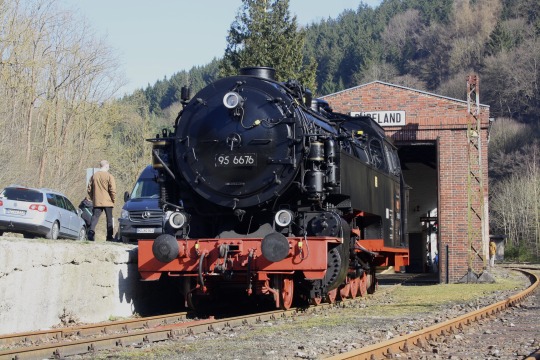
[Image: A picture of a steam locomotive Mammoth, nowadays labeled 95 6676, parked outside its locomotive shed in Rübeland]
These and the derived slightly newer Prussian T 20 locomotives used to haul a lot of limestone down the mountain.
In the 1960s, it was decided that inefficient steam locomotives needed replacing, and that more limestone should be produced. Diesel locomotives were considered, but ultimately, with the requirements, it was decided that electric would be better.
There were just two problems. One was political.
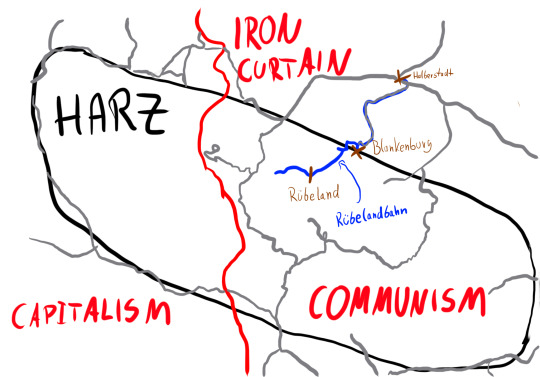
[Image: Hand-drawn map of the Harz with a red line denoting the Iron Curtain down the middle. The left is labeled “capitalism”, the right “communism”. The Rübelandbahn is drawn in blue and leads on the right side in a north-eastern direction out of the Harz. Other railway lines are drawn in gray.]
In the 1960s, we were deep in the Cold War, and Germany—as well as the entire world—was divided in two. The dividing line went straight through the middle of the Harz mountains. The Rübelandbahn itself was not affected, but it meant that the line was now, as seen from the new communist state, essentially alone at the end of the world.
The other issue is geography, and specifically the fact that everything north of the Harz is just flat and boring. The Rübelandbahn went through challenging terrain that made electrification necessary, but the lines leading away from it were flat and easy going. They have also always been fairly minor lines to begin with. There was no business case for electrifying them. In fact, they still haven’t been to this day, and I’m not holding my breath for that to change anytime soon.
The chosen solution was to electrify only the Rübelandbahn and nothing else, with the requirement to change locomotives down in Blankenburg. Stuff like that is by no means unusual around the world, but it is unusual for Germany. The main problem here is Germany’s electrification system: It uses 15 kV at the unusual frequency of 16.7 Hz, chosen because that was easier to handle in old locomotives than normal 50 Hz.
So the responsible people would now either have to build an expensive line to carry this weird 16.7 Hz electricity all the way to Rübeland, or install an expensive frequency converter there. Neither option was impossible by any means, but they were expensive. Instead, the people responsible decided to get creative: They electrified the line at 25 kV 50 Hz.
This was starting to become the new standard for new electrification systems around Europe at the time, and the railroaders in east Germany had liked the idea a lot. No more expensive converters, and just one standard voltage for everyone! Yes, it was incompatible with what West Germany was using, but in the middle of the Cold War, that was considered a feature, not a bug. In fact, there had been plans to use 50 Hz for all electrifications in the GDR. The pre-war electric rail equipment had been taken as reparations by the Soviet Union, so they were free to think of new things. Ultimately it was cheaper to buy back the pre-war locomotives from the Soviet Union than try to build all these all-new, expensive 50 Hz locomotives, so the classic 16.7 Hz was kept. But the Rübelandbahn was a chance to try again, and prove to the international world that the GDR could do 50 Hz. And then sell them 50 Hz locomotives, obviously.
For the line, a new series of locomotives was designed, the class E 251.
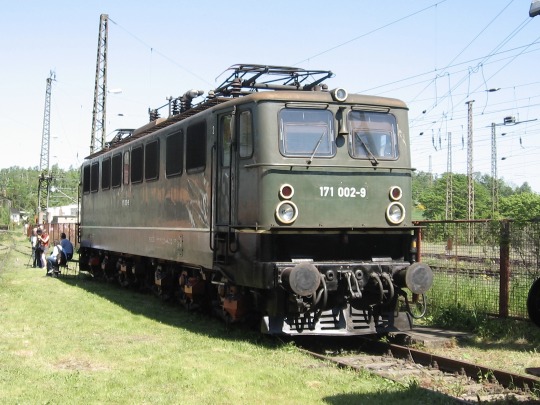
[Image: Photograph of a class E 251 electric locomotive in Blankenburg; this one is labelled as class 171, which was the class number they received in 1994.]
It was based on the then-standard locomotive classes E 11 and E 42, but longer, heavier, designed for tighter curves and lower top speeds. And, of course, for 50 Hz electrification. These 25 machines only ever saw service on this one line, but they were successful here, surviving until the late 1990s. Today, two are preserved. There were plans to sell the rest of the series to Romania, which also has 25 kV 50 Hz, but at fifty years old and with a top speed of only 80 km/h, they were considered not useful, and scrapped.
In the 2000s, the line went through some trouble. The quarry company had decided to hand over some of the freight contracts over to HVLE, a private freight company from Berlin. Since 1994 all german freight traffic is open access, meaning any company that has the necessary safety certificates can book train paths and run trains from anywhere to anywhere, so this was no problem in theory. However, HVLE had no 50 Hz electrics, so they ran with big diesel locomotives, like the “Blue Tiger”.

[Image: Picture of a Blue Tiger diesel locomotive in Rübeland.]
The “Blue Tiger” was a joint product of GE Transportation and Bombardier that didn’t sell well at all, but did find its home on this line. As a result, DB Netz, the owner of the line, decided it wasn’t worth the money to maintain the overhead lines anymore, so DB Cargo, the operator with the other freight contracts, also switched to diesel locomotives, in this case largely class 232 “Ludmilla” diesels built in the Soviet Union.
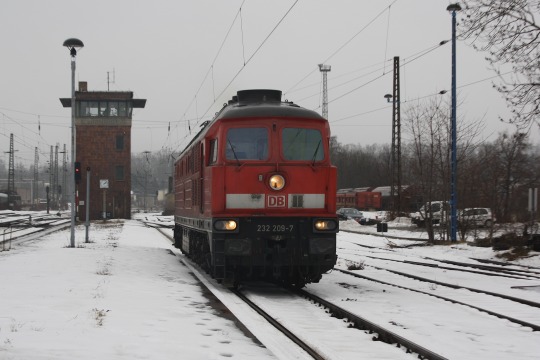
[Image: Picture of a red class 232 diesel locomotive in Blankenburg station.]
By that point diesel technology was at a point where this mountain line could work with diesels.
This proved incredibly unpopular with the people living near the line. These diesel machines are really, really loud. HVLE, who eventually took over all freight operations on the line, fitted some of their Blue Tigers with enhanced mufflers. Those did work, up to a point. I used to live next to another line where they operated, and you could always tell whether the one on the next freight train was one with or without this hush kit. Still, it was never quiet.
After years of complaints, the state government decided to jump in and paid for the restoration of the overhead lines and the power equipment. This time, for their electrification, they picked… 25 kV, 50 Hz, again. Because why not, right? You don’t need an expensive converter, and the line is prepared for it already anyway.
The main important thing is the rise of modern multi-system electrics: Any electric locomotive you’ve been able to buy for the past fifteen years can run with either of 15 kV 16.7 Hz or 25 kV 50 Hz. HVLE uses bog-standard class 185 locomotives, also known as Bombardier TRAXX 2 F140 AC, and yes, that is quite a mouthful. For the americans here, this locomotive is related to NJT’s ALP-46 and ALP-45DP. There’s several hundreds of those in Germany, and almost everybody uses them. HVLE are just the only ones who use the 25 kV mode on a line entirely within Germany.

[Image: Picture of a class 185 electric locomotive in Rübeland station.]
Oh, but changes are ahead! The 185, cheap as it is, has never been a perfect fit for the line. The problem is that it has only four axles. The total amount of pulling force a locomotive can provide is limited by the amount of weight it has on the wheels; if you put a stronger motor on, you will only get wheelspin (called slipping in the railway world). And the amount of weight you can put on each axle is limited, in Germany to 22.5 metric tons, because otherwise it damages the tracks too much. A six-axle machine would be much better, but there was none available. Now, however, there is:
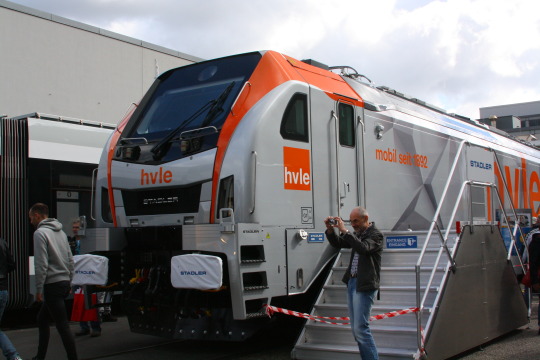
[Image: Picture of a Stadler Eurodual locomotive at the Innotrans railway exhibition in Berlin in 2018, where it was parked so it was completely impossible to get a good picture of it.]
The Stadler Eurodual is a six-axle locomotive that is both a powerful diesel locomotive and a powerful electric locomotive, which can run on both 15 kV and 25 kV. HVLE are using theirs all over Germany, including on the Rübelandbahn line. It can run a train down from the mountain, through Blankenburg and all the way to basically everywhere in Germany without stopping (except to change directions at the switchback). The manufacturer also claims that it damages the tracks less in tight curves than the four-axle alternatives, as those have very cheap bogie designs generally speaking.
So just like when the cog wheel sections were removed, modern technology has once again made the differences of the Rübelandbahn irrelevant. It’s still a very impressive line, though. If you’re in the area (most likely because you’re planning to ride steam trains from HSB), check it out.
It doesn’t have regular passenger service, that was never big and finally stopped in 2004, but there are regular steam excursion trains (roughly once a month give or take), using a prussian T 20 locomotive.

[Image: A prussian T 20 steam locomotive shunting in Rübeland]
All pictures and illustrations taken or drawn by me; if you want you can use them under CC-BY-SA. You can also find this post and its images on my DeviantArt, which is all rail photography and these days rarely updated.
13 notes
·
View notes
Text
S-Bahn: Spandau: Ausbau der Bötzowbahn, aus Senat
S-Bahn: Spandau: Ausbau der Bötzowbahn, aus Senat
06.10.2022 Frage 1:Wie ist der aktuelle Stand der Planungen?Antwort zu 1:Das Land Berlin und die #Havelländische Eisenbahn AG (#HVLE) haben eine Finanzierungsvereinbarung über die „Erstellung der Planung (HOAI1-Leistungsphase 2)“ für die #Infrastrukturmaßnahme „Ausbau der #Bötzowbahn für einen #S-Bahnverkehr“ abgeschlossen. Derzeit bereitet dieHVLE die Ausschreibung für diese Planung in…
View On WordPress
1 note
·
View note
Photo

185 641 in Rübeland am 22.05.2018
#185 641#Br185#Br 185#Güterzug#Rübeland#Rübelandbahn#HVLE#Eisenbahn#Bahnhof#Bahn#Harz#Ostharz#Bodetal
11 notes
·
View notes
Photo

185 640 schiebt Ihren Zug in Richtung Werk2/Elbingerode am 22.05.2018
#185 640#Br185#Br 185#Eisenbahn#Bahnhof#Bahn#HVLE#Harz#Ostharz#Rübeland#Rübelandbahn#Elbingerode#Werk2
7 notes
·
View notes
Photo

Rübeland am Morgen des 22.05.2018. Die Teilung des Zuges ist erfolgt und 185 641 fährt mit dem vorderen Teil in das Werk bei Rübeland.
#185 641#Br185#Br 185#HVLE#Güterzug#Zugteilung#Rübeland#Rübelandbahn#Eisenbahn#Bahnhof#Bahn#Bodetal#Harz#Ostharz
5 notes
·
View notes